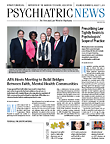Use of second-generation antipsychotics (SGAs) concurrent with other psychotropic medications in children in the Medicaid program has increased in recent years, according to a report published online in the Journal of American Academy of Child and Adolescent Psychiatry.
In the four-year period beginning in 2004, use of SGAs increased markedly and were frequently used along with one of four other classes of drugs, were used for long periods, and were increasingly prescribed in less-impaired children, the researchers found.
“The present study illustrates that the trend of increasing SGA use, which is occurring in the context of stable or declining use of other medication, is due in large part to sustained concurrent use of SGAs with other medications, an exposure that is known to have serious side effects and unknown long-term effects and drug-drug interactions,” the researchers stated. “Even more problematic is that the exposure to concurrent SGA is increasing disproportionately among youth with less perceived comorbidity and impairment. Such trends indicate a growth in off-label prescribing among children for whom evidence of benefit is lacking.”
In the study, researchers at Children’s Hospital of Philadelphia led by David Rubin, M.D., co-director of the Policy Lab at the hospital, used data from the Medicaid program to estimate the probability and duration of concurrent SGA use with different psychotropic medication classes over time and to examine concurrent SGAs in relation to clinical and demographic characteristics. Their analysis describes the epidemiology of concurrent SGA use with four psychotropic classes (stimulants, antidepressants, mood stabilizers, and alpha agonists) among a national sample of Medicaid-enrolled children aged 6 to 18.
A “pattern” was identified when one or more psychotropic medication class was used for at least 14 consecutive days. Initially, all mutually exclusive psychotropic treatment patterns were identified in each of the study years; for example, stimulant alone and stimulant with antidepressant constituted two separate patterns. This process resulted in the identification of 101 unique patterns. The 30 most common patterns were retained, encompassing all medication use for 99.7 percent of the children in the sample. A child was identified as a user of psychotropic medications if he or she had at least one psychotropic treatment pattern within a year.
The data analysis showed that while SGA use overall increased by 22 percent during the four-year period, about 85 percent of such use occurred concurrently with use of other psychotropic medications. By 2008, the probability of concurrent SGA use ranged from 0.22 for stimulant users to 0.52 for mood-stabilizer users. The concurrent SGA use occurred for long durations (69 percent to 89 percent of annual medication days).
Although the highest users of concurrent SGA and other medications were children in foster care and disability Medicaid programs or children with behavioral hospitalizations, the most significant increases over time occurred among children who were income-eligible for Medicaid, did not have comorbid attention-deficit/hyperactivity disorder (ADHD), were not hospitalized, and had no intellectual disability.
“We knew that antipsychotic use was increasing among youth, but were surprised to learn just how often children with ADHD or depression receive an antipsychotic as part of their treatment, and when they do, it is for sustained periods of time,” said Rubin. “In all likelihood, the use of the antipsychotics illustrates the great challenge clinicians are having when responding to disruptive and challenging behaviors in youth that don’t neatly fit common diagnostic categories. In a society that often doesn’t offer other services to respond to these behaviors, we should not be surprised at how quickly the use of antipsychotics has grown.”
Child and adolescent psychiatrist David Fassler, M.D., a clinical professor of psychiatry at the University of Vermont, said the findings of this study are consistent with previous reports and with general clinical experience: there has been a significant increase in the use of atypical antipsychotics in the treatment of children and adolescents.
But an important variable not addressed in the current study, said Fassler, was the Food and Drug Administration’s black-box warning on antidepressants issued in 2004—the first year of analysis in the study—which is likely to have significantly affected prescribing patterns, especially among pediatricians. “Although the authors noted that the increase in the use of these medications occurred in the context of ‘stable or declining use of other medication,’ they neglected to discuss the impact” of the label warnings that cautioned about suicidality risks with antidepressant use in children and adolescents, Fassler told Psychiatric News. “This would have been a helpful addition to the paper. Previous studies have suggested that this regulatory decision was at least partly responsible for the subsequent change in practice patterns.”
“The authors raise appropriate concerns about duration of treatment and the safety and efficacy of polypharmacy,” he added. “Ultimately, however, the issue isn’t simply how many kids are receiving which medication or combination of medications. The real question is whether or not children and adolescents with significant psychiatric disorders are getting the comprehensive evaluation and treatment services they need and deserve.” ■
“Growth in the Concurrent Use of Antipsychotics With Other Psychotropic Medications in Medicaid-Enrolled Children” can be accessed
here.
